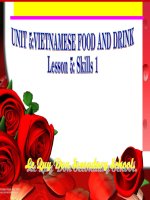Unit 1 lesson 2 a closer look 1
Bạn đang xem bản rút gọn của tài liệu. Xem và tải ngay bản đầy đủ của tài liệu tại đây (167.89 KB, 5 trang )
Tiết thứ 3
UNIT 1: HOBBIES
Lesson 2: A closer look 1
Class
7A
7B
7C
Date of teaching
..../09/2022
..../09/2022
..../09/2022
Attendence
I. OBJECTIVE: By the end of this lesson, students will be able to
1. Knowledge:
- To introduce topic of the lesson My hobbies. To teach some new words .
+ Vocabulary: Using the words related to hobbies; Verbs of liking and disliking
+ Coins, judo, jogging, yoga ; making models; - Do judo, yoga (karate, exercise...);
Go jogging, swimming (camping, cycling..); Collect dolls, coins (books, watches,
pencils ....)
+ Language: use of like/love/enjoy/hate + V-ing; talking about likes and dislikes.
+ Pronunciation: Correctly pronounce words that contain the sounds /ə/ and /ɜ:/
2. Competence:
a) General competencies:
Students will be able to learn how to use some new words. Know how to use
some action verbs go with Nouns to describe hobbies. Ss may add more nouns that can
go with these action verbs.
- Develop communication skills and creativity.
- Be collaborative and supportive in pair work and teamwork.
- Actively join in class activities.
b) Specific competencies:
- Group work and independent working, pair work, linguistic competence,
cooperative learning and communicative competence.
- Ability of using Present Simple Tense, some popular verbs of liking.
- Sts can introduce themselves or one another fluently.
3. Qualities: Love talking about their hobbies; having benefits of their hobbies in
daily life. Develop self-study skills.
II. PREPARATIONS
Teacher: Grade 7 text book, laptop, TV, pictures and realia, Computer connected to
the Internet. Sach mem.vn
Students: Text books, pencils, pics, blank papers, realia,….
III. PROCEDURE:
In each activity, each step will be represented as following:
* Deliver the task.
** Implement the task.
*** Discuss.
* Give comments or feedback.
1. WARM-UP (5’- GW/PW/IW)
+ Aim:
- To create an active atmosphere in the class before the lesson
- To lead into the new lesson.
+ Content: Review the previous lesson.
+ Products: Having a chance to speak English and focus on the topic of the lesson..
+ Implementation: Teacher’s instructions…
TEACHER’S & STUDENT’S ACTIVITIES
CONTENT
+ Greeting
+ Greeting
+ Asking questions:
+ Asking questions:
* Some students are invited to answer.
* Teacher asks students some
** Teacher and students discuss the answers.
questions about the hobbies:
*** Teacher introduces the lesson.
1. What is your favorite hobby?
- Show some pictures of the hobbies Ss learnt 2. When did you start your hobby?
in the previous lesson. Have some say the
- T - Ss
hobbies. Lead to this lesson which focuses on - Students (Ss) listen and learn how
action verbs, verbs of liking and disliking and to do.
the sounds /ә/and /з:/.
- Open their book and write .
**** Ask Ss to open their book and introduce
what they are going to study….
ACTIVITY 2: KNOWLEDGE FORMATION (15'- PW/IW)
+ Aim : To present some action verbs go with nouns to describe hobbies.
+ Content: Teach some new words, some action verbs go with nouns.
+ Products: Ss learn how to use them. Put them in the columns correctly.
+ Implementation:
Teacher’s & Student’s activities
Content
1. Complete the word webs below with the
1. Complete the word webs below
words from the box.
with the words from the box.
* Vocabulary
* Pre- teach vocabulary:
- coins (n)
tiền xu (tiền kim loại)
- Teacher uses different techniques to teach - judo (n)
môn võ Judo
vocabulary (situation, realia, translation .....)
- jogging (n) chạy bộ thể dục
+ Teacher may introduce the vocabulary by:
- yoga (n)
Sự tập luyện dô-ga
- providing explanations of the words;
- showing picture illustrating the word.
+ Follow the steps to teach vocabulary
- Repeat in chorus and individually
Suggested answer:
+ Check vocabulary: R&R
- go: jogging, swimming (others: go
- Teacher checks students’ understanding with
camping, go fishing, go cycling, etc.)
the “Rub out and remember” technique.
- do: judo, yoga (others: do karate,
+ Take note
do exercise, do sit-ups, etc.)
- Have Ss read the action verbs and match
- collect: dolls, coins (others: collect
them with the suitable words. Remind them
books, collect watches, collect
that a verb can go with more than one word.
pencils, etc.)
- Have Ss work in pairs to compare their
answers before they give T the answers.
- Check and confirm the correct answers.
Then have Ss add more words that can go
with these action verbs.
- Have Ss read the Remember! box. Ask
them to make some examples with the verbs
of liking and disliking.
- Check the answers as a class.
** Remember
- Common verbs of liking and disliking are
like, love, enjoy, and hate (not like). We often
use the –ing form after these verbs.
Example:- I like gardening.
- She hates watching TV.
ACTIVITY 3. PRACTICE (15’-IW, PW, GW)
+ Aim: To help Ss practise the verbs of liking / disliking and action verbs
+ Content: Complete the sentences, using the - ing form; Making sentences using the
pictures and verbs of liking or disliking; Listen and repeat , pay attention to the
sounds /ә/and /з:/; help Ss identify & practise how to pronounce the sounds /ә/and /з:/
+ Products: Ss can learm how to use verbs of liking and disliking; Ss can make
sentences correctly, using the pictures.
+ Implementation:
Teacher’s Student’s activities
Content
2. Complete the sentences, using the –ing 2. Complete the sentences, using
the –ing form of the verbs from the
form of the verbs from the box.
- Have Ss do this activity individually. Have box.
1. collecting 2. going
Ss read all the sentences carefully to make
3. playing
4. making
sure they understand the sentences.
5. doing
- Let them share their answers in pairs. Invite
some Ss to give the answers.
- Write the correct answers on the board.
3. Look at the pictures and say the 3. Look at the pictures and say the
sentences. Use suitable verbs of liking or sentences. Use suitable verbs of
disliking and the –ing form.
liking or disliking and the –ing
- Have Ss look at the pictures in this exercise form.
and say what the person / people is / are doing 1. He hates / doesn't like doing judo.
in each picture.
2. They like / love / enjoy playing
- Ask them what the face in each picture football.
means. (A sad face means ‘don't like’ and a 3. They love / like / enjoy gardening.
happy face means 'do like'.) Ask Ss to look at 4. They enjoy / like / love collecting
the example to make sure they understand stamps.
what to do.
5. She hates / doesn't like riding a
- Ask Ss to work in pairs to make sentences.
horse / horse riding
- Invite Ss to share their answers. Confirm the
correct answers.
- This activity can also be organised as a
competitive game. Have pairs write down the
sentences. The pair that finishes first with the
most correct answers wins.
- If there is time, invite some Ss to make
sentences about what they like or dislike
doing.
- T and other Ss give comments.
4. Listen and repeat. Pay attention to the
4. Listen and repeat. Pay attention
to the sounds /ә/and /з:/
sounds /ә/and /з:/
- Have some Ss read out the words first. Then - Listen carefully
- Listen and repeat
play the recording for them to listen and
repeat the words they hear.
- Ask them to pay close attention to the two
sounds.
- Play the recording as many times as
necessary.
- Explain to Ss the difference between the two
sounds if needed.
- Tell Ss that /ә/ is the same sound while /з:/
sounds like it has a soft /r/ in it.
- Invite some Ss to say some words they know
that include the two sounds.
ACTIVITY 4: APPLICATION (5' - IW)
1. Aim: To help Ss pronounce the sounds /a/ and /3:/ correctly in sentences.
2. Content:
Pratice saying the words pay attention to the underlined parts
Home assigment
3. Products:
Ss learn how to pronounce the words , the underlined parts correctly.
Take note Home assigment
4. Implementation: Teacher’s instructions…
5. Listen to the sentences and pay attention
to the underlined parts. Tick (✓) the
appropriate sounds. Practise the sentences
- Have Ss quickly read the sentences.
- Now play the recording for Ss to listen to the
sentences.
- Ask them to pay attention to the underlined
parts and tick the appropriate sounds.
- Invite some Ss to share their answers.
- Confirm the correct ones.
- Play the recording again for Ss to repeat the
sentences.
- Have Ss practise the sentences in pairs.
- Invite some pairs to read the sentences
aloud.
- Comment on their pronunciation of the
sounds
5. Listen to the sentences and pay
attention to the underlined parts.
Tick (✓) the appropriate sounds.
Practise the sentences
/ə/
1.
My
hobby
is
collecting dolls.
2. I go jogging every
Thursday.
3. My cousin likes
getting up early.
4. My best friend has
thirty pens.
5. Nam enjoys playing
the violin.
/ɜ:/
✔
✔
✔
✔
✔
V. FEEDBACK:
With 7A ……………………………………………………………………………..…
With 7B …………………………...……………………………………..……………
With 7C ………………………………………………………………………….……









